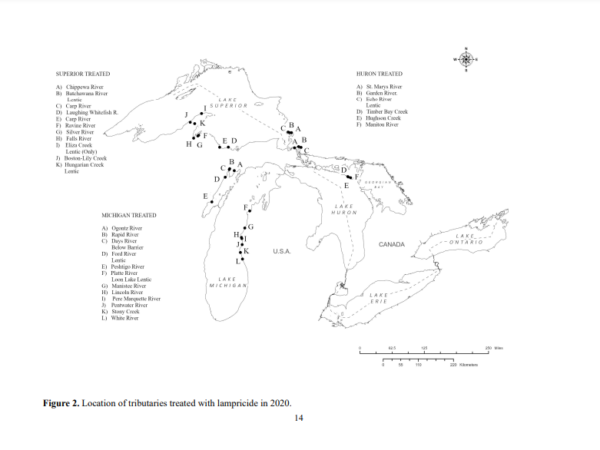
By Brian Allnutt, Planet Detroit
This article was republished with permission from Planet Detroit. Sign up for Planet Detroit’s weekly newsletter here.
After a relatively subdued spring and early summer, Canadian wildfires are once again spreading and burning millions of acres, forcing the evacuation of 9,000 residents in Labrador and Newfoundland and threatening operations in the oil-producing hub of Fort McMurray, Alberta.
“It’s been growing steadily for the last couple of weeks,” Brian Wiens, managing director of the research partnership Canada Wildfire, told Planet Detroit. “A few days ago, we had a whole bunch of new starts and some of the existing fires started to take off a little bit.”
Smoke from Canadian wildfires has moved across the border, leading to several days of poor air quality in states like Minnesota and North Dakota. But this year’s fires are a fraction of the size of the blazes that broke out across Canada in 2023, contributing to 11 days of significant particulate matter pollution in Detroit.
For now, Michigan is unlikely to experience severe impacts from ongoing fires in Canada or the western U.S., where large fires broke out during a recent heatwave and increasingly dry conditions. Yet fires in nearby provinces or a change in weather conditions could again bring significant smoke to Michigan.
A report in the Detroit Free Press found that Canada’s wildfire problem, in addition to being accelerated by climate change, is also driven by decades of fire suppression to protect populated areas. This disruption of natural fire cycles allows for denser tree growth and dead and dry material to accumulate on the forest floor, helping fuel last year’s fire and smoke season.
In Detroit, the smoke led to an uptick in emergency room visits, with residents experiencing coughs, wheezing and shortness of breath. Wildfire smoke carries PM 2.5 or fine particulate matter, which is linked to cardiopulmonary illness and premature mortality. It can also contribute to ozone formation, a trigger for asthma attacks and other respiratory problems.
Canadian wildfires send smoke to the Great Lakes as drought persists in the west
The Great Lakes region is already receiving smoke from northern Alberta and Saskatchewan, but Wiens said air quality impacts from fires that far away tend to be smaller and short-lived. However, the fire threat in western provinces is likely to persist, with large areas under “extreme” and “severe” drought conditions.
Canadian wildfires pose a special threat to air quality because of the sheer size of the country’s forests and the type of trees they contain. Boreal forest covers much of the country, which is composed mostly of coniferous trees like spruces and pines that are more flammable than deciduous trees.
A little under 4 million acres have burned in 2024, below the long-term average for this time of year. In 2023, 27 million acres had already burned by this point in the season, Wiens said.
Yet, Canada’s Fire Weather Index, which measures fire danger, shows high-risk levels across much of Western Canada, although most of Ontario and Quebec are at the lowest level.
Wiens said the ongoing drought in western provinces means fuel doesn’t take long to dry out, adding that this has coincided with a period of hot weather and lightning.
“In certain patterns, you get lightning that doesn’t have much rain with it, so then you don’t even get the protective effect of some rainfall to soften the blow,” he said. “That’s kind of where we’re at right now.”
Wiens said most provinces have increased their staffing for fire crews after running short in 2023.
What could change the smoke outlook for Detroit
While the relative lack of fire conditions in Eastern Canada bodes well for Detroit, fires in Western Canada led to several days of extremely bad air quality last July.
Smoke from distant fires normally remains higher in the atmosphere, but last year, a low-pressure system arrived with the smoke and pulled it down to ground level, according to Alec Kownacki, a meteorologist with the Michigan Department of Environment, Great Lakes, and Energy Air Quality Division.
“It was a very specific scenario that happened last year,” he said. “It has to line up perfectly for that to happen.”
Kownacki said he had observed an uptick in fire activity in recent weeks, including fires in northern Ontario, near St. James Bay, due north of Michigan. Some of these only appeared on the Canadian government’s interactive fire map in the last week or so.
This year’s shift from an El Niño weather pattern to a La Niña could also make the fire weather forecast more uncertain, Wiens said. La Niña usually brings cooler weather and more precipitation to Canada. But Wiens said the transition between the two weather patterns can be unpredictable, and increased precipitation can also mean lightning and more fire starts.
Planet Detroit will continue tracking air quality for those concerned about wildfire smoke. The U.S. government offers a map of wildfire smoke at fire.airnow.gov, and Canada provides an animated smoke forecast at firesmoke.ca/forecasts/current.
If pollution levels are high, experts advise staying indoors in air conditioning and wearing an N95 of KN95 mask outdoors.
Catch more news at Great Lakes Now:
Expecting smoke to be a more frequent part of seasonal planning
Surviving a metro Detroit summer in the climate change era
Featured image: Map from FireSmoke Canada shows wildfire smoke from Western Canada in the Great Lakes region.




